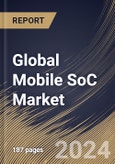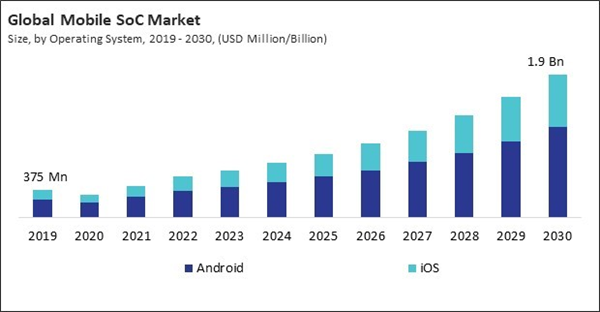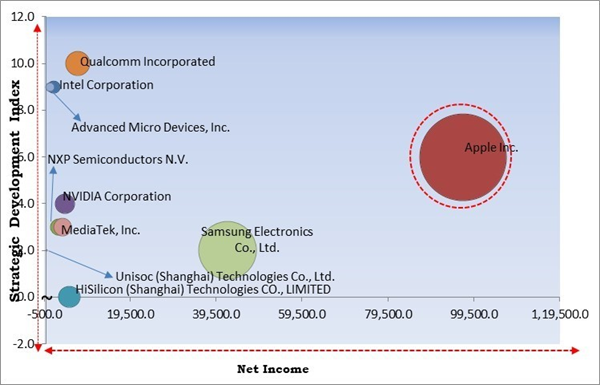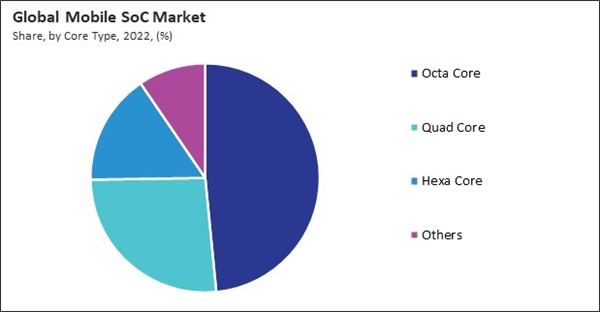The Global Mobile SoC Market size is expected to reach $1.9 billion by 2030, rising at a market growth of 17% CAGR during the forecast period.
The rollout of 5G networks in North America has been a major driver for the market. As 5G infrastructure expands, there is an increasing need for SoCs to support the higher data speeds, lower latency, and improved connectivity offered by 5G technology. Consequently, the North American region would acquire nearly, 25% of the total market share by 2030. Mobile devices with integrated 5G modems are in demand, and SoC manufacturers are responding to this trend. Therefore, the segment will witness enhanced demand in the upcoming years.
The major strategies followed by the market participants are Product Launches as the key developmental strategy to keep pace with the changing demands of end users. For instance, in January, 2024, NXP Semiconductors N.V. announced the launch of SAF86xx, an integrated radar System-on-Chip (SOC) that includes a high-performance transceiver, multi-core processor, and MACsec hardware engine for secure data communication. The SAF86xx streams low-level sensor data at 1 Gbit/s, optimizing Advanced Driver Assistance Systems (ADAS) partitioning for software-defined vehicles. Moreover, in December, 2023, Intel Corporation released Core Ultra H mobile processors. This series features four SKUs, including two Ultra 7 16-core chips and two 14-core Ultra 5 chips. The processors in the Ultra Core H series are designed for ultra-portable notebooks, offering enhanced performance in both computing and graphics while maintaining a slim form factor. They run at a base TDP of 28W, with a maximum turbo TDP of up to 115W.
The contemporary consumer landscape is marked by escalating expectations for high-performance mobile devices, driving a compelling need for cutting-edge mobile system-on-chip (SoC) solutions. Moreover, these SoCs, functioning as the heart and brains of these devices, play a pivotal role in meeting these demands. Manufacturers are thus under pressure to develop sophisticated SoCs that cater to the growing appetite for superior performance and strike a delicate balance between processing prowess and energy conservation. Therefore, these factors will assist in the growth of the market.
The rollout of 5G networks in North America has been a major driver for the market. As 5G infrastructure expands, there is an increasing need for SoCs to support the higher data speeds, lower latency, and improved connectivity offered by 5G technology. Consequently, the North American region would acquire nearly, 25% of the total market share by 2030. Mobile devices with integrated 5G modems are in demand, and SoC manufacturers are responding to this trend. Therefore, the segment will witness enhanced demand in the upcoming years.
The major strategies followed by the market participants are Product Launches as the key developmental strategy to keep pace with the changing demands of end users. For instance, in January, 2024, NXP Semiconductors N.V. announced the launch of SAF86xx, an integrated radar System-on-Chip (SOC) that includes a high-performance transceiver, multi-core processor, and MACsec hardware engine for secure data communication. The SAF86xx streams low-level sensor data at 1 Gbit/s, optimizing Advanced Driver Assistance Systems (ADAS) partitioning for software-defined vehicles. Moreover, in December, 2023, Intel Corporation released Core Ultra H mobile processors. This series features four SKUs, including two Ultra 7 16-core chips and two 14-core Ultra 5 chips. The processors in the Ultra Core H series are designed for ultra-portable notebooks, offering enhanced performance in both computing and graphics while maintaining a slim form factor. They run at a base TDP of 28W, with a maximum turbo TDP of up to 115W.
Cardinal Matrix - Market Competition Analysis
Based on the Analysis presented in the Cardinal Matrix; Apple Inc. is the forerunner in the Market. In June, 2023, Apple introduced the M2 Ultra, a new system-on-a-chip (SoC) that delivers significant performance increases to the Mac. The M2 Ultra consists of 134 billion transistors, making it more powerful than the M1 Ultra, which had 114 billion transistors. Additionally, it Features a unified memory architecture supporting up to 192GB of memory capacity, a 50% increase from M1 Ultra, with 800GB/s of memory bandwidth, twice that of M2 Max. Companies such as Samsung Electronics Co., Ltd., Qualcomm Incorporated and NVIDIA Corporation are some of the key innovators in Market.Market Growth Factors
5G promises significantly faster data speeds, lower latency, and increased network capacity. To fully leverage the benefits of 5G, mobile devices require powerful SoCs capable of handling the increased data throughput and supporting advanced communication protocols. Moreover, powerful GPUs integrated into these SoCs support high-quality graphics rendering for gaming, video playback, and AR/VR applications. These SoCs are designed to handle advanced multimedia processing, including high-definition video playback, 3D rendering, and efficient video encoding and decoding. Thus, these aspects will boost the demand in the coming years.The contemporary consumer landscape is marked by escalating expectations for high-performance mobile devices, driving a compelling need for cutting-edge mobile system-on-chip (SoC) solutions. Moreover, these SoCs, functioning as the heart and brains of these devices, play a pivotal role in meeting these demands. Manufacturers are thus under pressure to develop sophisticated SoCs that cater to the growing appetite for superior performance and strike a delicate balance between processing prowess and energy conservation. Therefore, these factors will assist in the growth of the market.
Market Restraining Factors
The intricate and sophisticated nature of modern SoCs, featuring densely packed transistors on a single chip, demands cutting-edge semiconductor manufacturing technologies. As the industry progresses towards smaller node sizes, the expenses related to research, development, and implementation of advanced fabrication processes amplify. Additionally, upgrading or establishing semiconductor fabrication plants capable of handling the intricate specifications of modern SoCs requires substantial investments. Hence, these factors can restrain the demand for these SoCs in the upcoming years.By Core Type Analysis
On the basis of core type, the market is divided into octa core, quad core, hexa core, and others. In 2022, the quad core segment witnessed a substantial revenue share in the market. Quad-core configurations are often optimized for power consumption, making them suitable for devices where energy efficiency is a priority. This is crucial for users prioritizing longer battery life, a significant factor in the mobile device industry. The efficiency of quad-core processors contributes to a smoother user experience without compromising battery performance. Thus, these factors will pose lucrative growth prospects for the segment.By Operating System Analysis
Based on operating system, the market is segmented into Android and iOS. In 2022, the iOS segment garnered a significant revenue share in the market. Apple's mobile SoCs are known for their high performance and energy efficiency. Each new iteration of the A-series chips tends to improve processing power, graphics capabilities, and energy efficiency. This focus on delivering cutting-edge performance contributes to the demand for iOS-specific SoCs. Therefore, these factors can lead to increased demand in the segment.By Regional Analysis
By region, the market is segmented into North America, Europe, Asia Pacific, and LAMEA. The Asia Pacific segment procured the highest revenue share in the market in 2022. The Asia Pacific region has some of the largest and fastest-growing smartphone sectors globally. Smartphone adoption has increased dramatically in countries including China, India, South Korea, and Japan due to rising disposable income, urbanization, and the expansion of technologically proficient populations. The demand for these SoCs is closely tied to the production and sales of smartphones, making the region a focal point for SoC manufacturers. Hence, the segment will grow rapidly in the future.Recent Strategies Deployed in the Market
- 2023-Dec: Advanced Micro Devices, Inc. announced the launch of AMD Ryzen 8040 Series processors. The Ryzen 8040 Series is designed on the AMD "Zen 4" processor architecture, featuring up to eight cores capable of delivering up to 16 threads of processing power. Additionally, the processors come with AMD RDNA 3 architecture-based Radeon graphics, and select systems are powered by AMD XDNA architecture built for AMD Ryzen AI.
- 2023-Oct: Qualcomm Incorporated unveiled the Snapdragon 8 Gen 3 mobile processor. The chip features the Qualcomm Hexagon neural processing unit (NPU) and is capable of running games at 240 frames per second on supported displays, highlighting its gaming performance capabilities.
- 2023-Oct: Unisoc (Shanghai) Technologies Co., Ltd. teamed up with itel, a smartphone manufacturing company. The collaboration aimed to create a benchmark reference smartphone for Android 14 (Go edition) to offer users an enhanced mobile experience.
- 2023-May: NVIDIA Corporation partnered with MediaTek, a multimedia solutions provider. The partnership aimed to transform the automotive industry by combining their respective strengths in system-on-chip (SoC) technology, artificial intelligence (AI), and graphics processing units (GPU).
- 2022-May: Intel Corporation acquired Siru Innovations, a Finland-based silicon building blocks developer. The acquisition strengthens Intel's capabilities in discrete graphics and accelerated computing.
List of Key Companies Profiled
- NVIDIA Corporation
- HiSilicon (Shanghai) Technologies CO., LIMITED (Huawei Technologies Co., Ltd.) (Huawei Investment & Holding Co., Ltd.)
- Intel Corporation
- Apple Inc.
- Advanced Micro Devices, Inc.
- Qualcomm Incorporated
- Unisoc (Shanghai) Technologies Co., Ltd. (Wise Road Capital LTD)
- MediaTek, Inc.
- NXP Semiconductors N.V.
- Samsung Electronics Co., Ltd. (Samsung Group)
Market Report Segmentation
By Operating System- Android
- iOS
- Octa Core
- Quad Core
- Hexa Core
- Others
- North America
- US
- Canada
- Mexico
- Rest of North America
- Europe
- Germany
- UK
- France
- Russia
- Spain
- Italy
- Rest of Europe
- Asia Pacific
- China
- Japan
- India
- South Korea
- Singapore
- Taiwan
- Rest of Asia Pacific
- LAMEA
- Brazil
- Argentina
- UAE
- Saudi Arabia
- South Africa
- Nigeria
- Rest of LAMEA
Table of Contents
Chapter 1. Market Scope & Methodology
Chapter 2. Market at a Glance
Chapter 3. Market Overview
Chapter 4. Competition Analysis - Global
Chapter 5. Global Mobile SoC Market by Operating System
Chapter 6. Global Mobile SoC Market by Core Type
Chapter 7. Global Mobile SoC Market by Region
Chapter 8. Company Profiles
Companies Mentioned
- NVIDIA Corporation
- HiSilicon (Shanghai) Technologies CO., LIMITED (Huawei Technologies Co., Ltd.) (Huawei Investment & Holding Co., Ltd.)
- Intel Corporation
- Apple Inc.
- Advanced Micro Devices, Inc.
- Qualcomm Incorporated
- Unisoc (Shanghai) Technologies Co., Ltd. (Wise Road Capital LTD)
- MediaTek, Inc.
- NXP Semiconductors N.V.
- Samsung Electronics Co., Ltd. (Samsung Group)
Methodology

LOADING...











